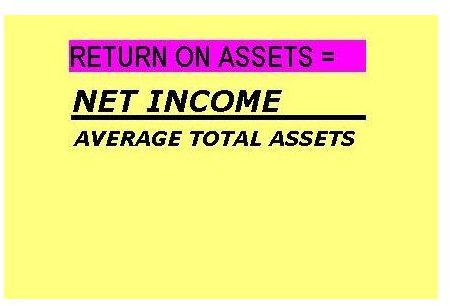Understanding Return on Assets Ratio
Formula
Return on Assets ratio (ROA) is Net Income divided by Total Assets. It indicates the profits or earnings that a company makes using the wealth at its disposal, or the returns generated using each available dollar.
ROA = Net Income / Average Total Assets
When determining net income, one approach is to consider only the net income value that finds mention in the income statement. Another approach is to add the net interest expenses (total interest expense less interest tax savings) to the net income value in the income statement.
Total Assets are part of the balance sheet. Since the exact level and value of assets vary over time, net total assets for ROA is the average value of the company’s assets during the statement period.
Another formula, albeit more complicated to calculate ROA, is Net Profit Margin x Asset Turnover. Net Profit Margin is net income or profit divided by total revenue. Asset Turnover is the average of all assets divided by total revenue, all for the accounting period under consideration.
Image by N Nayab
Uses
Return on Assets (ROA) ratio reveals the ability of a company to leverage the resources under its control and reveals the profitability of the company relative to its assets. There is no uniform desired value for Return on Assets ratio.
ROA finds widespread use in financial analysis by investors to make investment decisions and by companies to determine the viability of entering new ventures.
Investors use Return on Assets ratio to compare two or more companies in the same industry, or the ability of the company to leverage its resources over different periods. They prefer companies with high ROA, which usually indicates good financial management and good returns for investments. A low ROA usually indicates the company’s inability to make optimal use of available resources.
Companies evaluating different projects prefer to select projects that generate higher returns on assets. Companies also apply ROA to determine the viability of a project. For instance, a project that requires funding at 12 percent interest and which has a ROA of only 10 percent is not commecrially viable even though it has the potential to make profits.
Example
Assume Company A has a net income of $5 million and total assets worth $20 million. Its ROA is 25 percent. Company B with the same net income of $5 million might have total assets of only $10 million and therefore an ROA of 50 percent. Company C with total assets worth $50 million might have a net income of $10 million, and ROA of 20 percent. Which of these scenarios is most attractive?
Now, repeating the scenarios:
- Company A has a net income of $5 million and total assets worth $20 million. Its ROA is 25 percent.
- Company B with the same net income of $5 million has total assets of only $10 million and therefore an ROA of 50 percent.
- Company C with total assets worth $50 million might have a net income of $10 million, and ROA of 20 percent.
Using Return on Assets ratio (ROA) analysis, investors would find Company A more attractive than company C although company C has double company A’s net income, for company A has generated the profit using much less resources. The same investor would prefer company B over company A even though the net income of these two companies remains the same, for the same reason. From the above example, application of Retun on Net Assets ratio indicates that company B converts the investor’s cash and debt money available at its disposal much better than Company A or C did.
Distorters
A major distorter of Return on Assets Ratio (ROA) is the total assets. ROA calculates asset value on the book value or carrying value, which bases itself on the original cost of the asset less depreciation, amortization, or impairment costs made against the asset. The market value of the same asset may have no relation to the book value. For instance, a company renting out a building constructed spending $100,000 for $20,000, excluding all maintenance and taxes, has a return of asset for $20,000/$100,000 * 100 = 20 percent. The market value of the building may, however, be $500,000, meaning that the actual ROA is $20,000/$500,000 * 100 = 4 percent.
Another distorter occurs because different industries have different capital requirements, and therefore ROA does not make a good method to compare two disparate industries. An oil refinery set up at a total cost of $10,000,000 may yield an annual profit of $100,000, with ROA of just one percent, whereas another oil refinery with the same investment may yield an annual return of only $75,000, with ROA of 0.75 percent, revealing operational or logistics inefficiencies of the second oil refinery. In contrast, a consultancy firm with an investment of $50,000 might provide an annual return of $5,000, or ROA of 10 percent.
Return on Assets ratio, while providing a good indication of the viability of the business and the competence of the management, does not however provide any conclusive results about a company. This financial ratio is best used with other ratios and financial statements to obtain a complete picture about the company.
